Providing Outdoor Access for Cattle
 One of our key principles of sustainable livestock production is to provide animals with outdoor access, shade, shelter, lighting and sufficient space. Whilst this approach provides animals with an environment that gives them free movement and the ability to behave naturally, there are also disease risks to consider as well as the risks from predation and pests and climatic extremes. In this section, we consider those risks, the impact on welfare, and suggested approaches to minimising them while maximising the benefits of being outdoors.
One of our key principles of sustainable livestock production is to provide animals with outdoor access, shade, shelter, lighting and sufficient space. Whilst this approach provides animals with an environment that gives them free movement and the ability to behave naturally, there are also disease risks to consider as well as the risks from predation and pests and climatic extremes. In this section, we consider those risks, the impact on welfare, and suggested approaches to minimising them while maximising the benefits of being outdoors.
What happens when temperatures are too high?
The most important environmental factor affecting the normal physiological functioning of farmed animals is temperature. Cattle tend to be more susceptible than sheep to high temperatures, and they are most susceptible when they are producing (Silanikove, 2000). Dairy cattle will reduce feed-intake under heat stress resulting in lower milk production and reduced growth. Reproduction is also adversely affected (Wilson et al., 1998). In some areas, such as the south-eastern United States, heat stress on the lactating cow is one of the greatest production challenges facing dairy farmers (West, 2002).
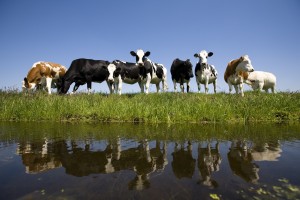 For most of the time, the body temperature of most domestic animals is considerably higher than the environmental temperature to which they are exposed. Whilst the body can tolerate short periods of heat stress, if the ambient temperature exceeds the body temperature for an extended period, this can prove fatal. Animals maintain their body temperatures by balancing internal heat production and heat loss to the environment. For example, in low temperatures cattle have the ability to convert feed to heat energy whilst at high temperature they increase respiration and blood circulation in the skin. Animals also change their behaviour in response to changing temperature, reducing activity and spreading limbs in hot conditions and huddling together in low temperatures.
For most of the time, the body temperature of most domestic animals is considerably higher than the environmental temperature to which they are exposed. Whilst the body can tolerate short periods of heat stress, if the ambient temperature exceeds the body temperature for an extended period, this can prove fatal. Animals maintain their body temperatures by balancing internal heat production and heat loss to the environment. For example, in low temperatures cattle have the ability to convert feed to heat energy whilst at high temperature they increase respiration and blood circulation in the skin. Animals also change their behaviour in response to changing temperature, reducing activity and spreading limbs in hot conditions and huddling together in low temperatures.
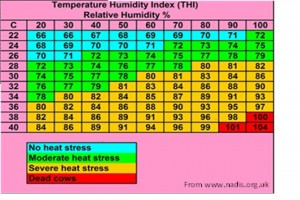 Cattle can tolerate higher temperatures if relative humidity is lower. The temperature-humidity index (THI) is a common approach to evaluating heat stress in dairy cattle, providing a single value to represent the combined effects of both temperature and humidity.
Cattle can tolerate higher temperatures if relative humidity is lower. The temperature-humidity index (THI) is a common approach to evaluating heat stress in dairy cattle, providing a single value to represent the combined effects of both temperature and humidity.
Signs of heat stress, such as increased water intake or reduced feed intake, may be subtle and therefore difficult to recognize. Other signs, such as increased respiration rate (greater than 90 breaths per minute), standing versus lying down, and congregating under shade or at water sources are more easily identified. As both temperature and humidity play a significant role in heat stress, looking at the combined impact of these factors can help identify potentially dangerous conditions for cattle.
In some areas of the US, where the climate is humid subtropical, extended periods of high ambient temperature and relative humidity dairy cows cannot dissipate sufficient body heat to prevent a rise in body temperature. In such situations, for milking herds, the use of water sprinklers are effective, although they are not necessarily conducive to achieving resource efficient and sustainable systems.
Heat stress is made worse in Kentucky and other humid parts of the eastern United States by the endophytic fungi that infect tall fescue, which is one of the most widely grown pasture grasses in the region. It’s estimated that up to 95% of tall fescue pastures are infected with endophytes. Cattle grazing endophyte infected pastures experience increased body temperatures, largely from their inability to effectively transfer heat from their skin by sweating (Schmidt et al., 1982; Hemken et al., 1984; Porter and Thomson, 1992).
The comfort zone
The temperature “comfort zone” for most farm animals is in the range 10 to 20°C. Within this range, normal heat regulation processes are sufficient to enable maintenance of bodily function, whereas at the extremes of this zone the animal must decrease or increase its metabolic heat production, and at more extreme temperatures, even this process becomes insufficient to maintain normal functioning. The impact is most dramatic in very young animals with under-developed heat regulating mechanisms.
Managing high temperatures
There are three categories of management strategies that can be adopted to reduce the effects of excess temperatures, with the impact of these being very dependent on the type of system and of course, the prevailing temperature:
- physical modification of the environment (shading, cooling)
- breeding and selection of heat-tolerant breeds
- improved nutritional management practices
For housed animals
Sufficient ventilation should be provided to ensure that animal heat and moisture can be effectively removed so as to maintain the housed environment within the animal’s comfort zone as well as avoiding the build-up of disease causing agents. Modifications including shade, buildings which enhance passive ventilation, and the addition of fans and sprinklers help to increase body heat loss, lowering body temperature and improving feed intake (West, 2002). More information on cattle housing can be found here.
With regard to breeding
Genetic selection for heat tolerance may be possible, but continued selection for high yield without accounting for heat tolerance will result in greater susceptibility to heat stress (Ravagnolo and Misztal., 2000). There are opportunities to breed for a degree of heat resistance in cattle as genes exist for regulation of body temperature and resistance to elevated temperature (Hansen, 2007).
Which cattle suffer the most from heat?
- Cattle with dark coats experience higher body temperatures than those with light coats
- Heavy cattle are more susceptible to heat stress than lighter cattle because of the increased fat deposits
- The increased metabolic heat produced by lactating cattle also makes them more susceptible to heat stress
- Sick or stressed cattle are also more affected by heat stress than healthy cattle.
Under high heat stress, Bos indicus (humped) breeds and their crosses have better heat regulatory capacity than the European Bos taurus breeds, due largely to differences in metabolic rate, food and water consumption, sweating rate and coat characteristics and colour (Blackshaw and Blackshaw, 1984), although some B.taurus breeds bred in the tropics (e.g. Senepol and Romosinuano) have been shown to have equivalent ability to respond to heat stress as B.indicus breeds such as the Brahman (Hammond et al., 1996).
Coat colour and coat type exert an influence on performance of cattle under heat stress. Dark coated animals and those with deep or woolly coats have been shown to spend less time grazing in hot sun than light coloured, smooth coated animals, and in turn this effects performance (Finch et al., 1984).
As for feeding cattle
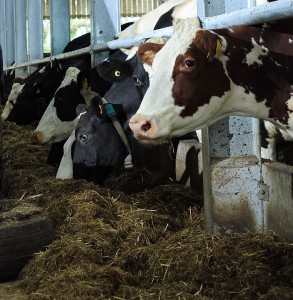 Under hot conditions, high yielding animals can suffer more than lower yielders as heat is produced when the animal metabolises feed that is converted into milk and meat. The internal heat production increases with increased production. The type of feeds provided can also be influential, in that high fibre diets of low digestibility require greater activity and hence increased heat production from metabolism. A common approach to increase energy density is to reduce forage and increase concentrated feeds, although this can present an increased risk of nutritional conditions such as acidosis (West, 2002) and also contradicts sustainable livestock practices.
Under hot conditions, high yielding animals can suffer more than lower yielders as heat is produced when the animal metabolises feed that is converted into milk and meat. The internal heat production increases with increased production. The type of feeds provided can also be influential, in that high fibre diets of low digestibility require greater activity and hence increased heat production from metabolism. A common approach to increase energy density is to reduce forage and increase concentrated feeds, although this can present an increased risk of nutritional conditions such as acidosis (West, 2002) and also contradicts sustainable livestock practices.
During hot weather, declining intake and high lactation demand requires increased mineral concentration in the diet. Alterations in mineral metabolism also affect the electrolyte status, of the cow during hot weather. Potassium is involved in sweating and sodium in the production of urine. Nutritional modifications, such as feeding cows with a high dietary cation-anion difference (DCAD) (see Milk Fever), may be necessary to account for changing nutrient requirements resulting from heat stress. Additional supplementation with potassium above recommended levels in hot conditions can be beneficial (West, 2002).
And of course water…
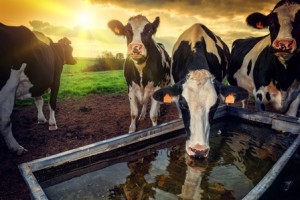 Water quality and certainly quantity are also likely to be important. High concentrations of sulphate and chloride in drinking water has been seen to jeopardize productivity of cows during hot weather (Sanchez et al., 1994). Water intake must be always readily available to animals at all times, particularly in hot conditions. It has been shown that water intake increases by 1.2 kg/°C increase in minimum ambient temperature (Murphy et al., 1982).
Water quality and certainly quantity are also likely to be important. High concentrations of sulphate and chloride in drinking water has been seen to jeopardize productivity of cows during hot weather (Sanchez et al., 1994). Water intake must be always readily available to animals at all times, particularly in hot conditions. It has been shown that water intake increases by 1.2 kg/°C increase in minimum ambient temperature (Murphy et al., 1982).
Providing shade for cattle
Heat stress is a welfare issue which can also result in significant decreases in feed intake, milk yield, fertility and weight gain. For dairy and beef cattle, the ideal ambient temperature is between 5°C and 25° C. Depending on levels of relative humidity, solar radiation, wind speed, access to water and diet, over this temperature cattle suffer heat stress. Controlling the amount of solar radiation that cattle receive is one of the best methods of reducing heat stress. Providing shade is an obvious solution, but radiation levels can also be significantly affected by the surrounding vegetation. Dry enclosures, including feed lots, with limited to no vegetation will reflect more light and heat than thick grass pastures, as will gravelled and concrete areas.
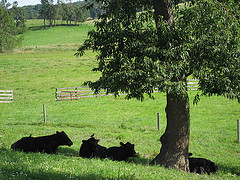
All cattle should not only have access to grazing and exercise areas but should also be provided with adequate shade and shelter to protect them from climatic extremes. On many farms, this is provided by natural vegetation but in certain situations it may be necessary to provide either temporary or permanent structures.
Cattle generally prefer shade from trees rather than constructed structures. Trees are effective at blocking incoming solar radiation, and moisture evaporating from their leaves helps cool surrounding air. Though natural shade is low-cost, often it is not where it is needed, and there are other disadvantages. If there are not enough trees for the number of cattle, they will congregate under the trees, eroding the soil and exposing the roots, which can damage or kill the trees.
In many cases, trees are located near riparian areas, and if cattle congregate in those areas, off-site runoff of soil and manure into adjacent streams or water bodies can occur. Using strategic plantings can increase natural pasture shade.
Permanent shade can be provided by constructing barns or sheds. It is most often provided for dry lots and bull lots and does not easily fit with the notion of a rotational grazing practices. Often in a grazing system, permanent shade is not located where it is needed, and it can be costly.
Portable, low-cost shade structures can be built. Shade placement will affect the animal grazing patterns and forage use, and therefore it is important to observe animal traffic patterns and adjust shade locations accordingly for best pasture use.
Exposure to winter weather
Exposure to winter weather affects both the physiological change in body temperature and the behaviour of cattle, and they will adjust their behaviour accordingly. Cattle kept outside spend more time in lying and standing postures that reduces the amount of surface area exposed to rain and wind compared to animals kept inside, or those provided with shelter. This is particularly true for thinner cows kept outdoors, who also spend less time eating during periods of cold (Tucker et al., 2007). Cows significantly reduce their feed intake exposed to rain and the combination of rain and wind (Schütz et al., 2010).

For some systems, provided that the breeds use are well-adapted to the conditions, keeping animals outdoors during winter months does not necessarily have negative impacts on production or welfare compared with indoor housing e.g. see Redbo et al., 1996.
Providing shelter and ensuring good body condition will help mitigate the effects of winter weather. There is some evidence that older cattle previously exposed to harsh winter will be better prepared than young animals (Christopherson, 1976; Beaver and Olson, 1997).
Whilst cattle initially avoid doing so, they will eventually lie on a wet surface in cold weather, they tend to adopt a posture that minimises the amount of surface area exposed to wet, cold ground (Tucker et al 2007). A well-designed shelter may reduce this type of behavioural response to winter weather.
Higher wind speeds partially destroy the insulation of the hair coat and increase convective heat loss. The use of windbreaks in grazed fields can significantly reduce the effects of high wind velocity by minimizing these losses, and hence reducing the use of energy reserves (Olson and Wallander., 2002). The initial body condition of animals exposed to excessive winds will determine the impact on their performance and to their behavioural response to the wind. In other words, animals in better condition fare better.
On cold sunny days cattle tend to stand perpendicular to the sun’s rays, particularly in the morning days, especially in the early morning (Gonyou and Stricklin, 1981), and during the day walking and tracking the sun save more energy than standing up and re-orienting.
Shelters can protect animals from pests and predators, and the design of these shelters can be significant. For example, shelters with roofs and walls are more successful at controlling the Culicoides midge, which is a vector of Blue Tongue, than shelters with walls or roofs alone (Doherty et al., 2004).
Cattle Predators
Losses to predators, and in particular coyotes, although generally low can be economically significant in some parts of the US (Gee, 1979), with the loss of beef calves being the most frequent. Cattle react to predatory stimuli (visual and smell), and can differentiate between stimuli from different predatory species (Kluever et al., 2009), but they reduce anti-predatory behaviour when they are kept with other species e.g. deer.
Although not necessarily protecting cattle, bonding sheep to cattle has been shown to be an effective method for reducing coyote depredation on sheep (Hulet et al.,1987; Anderson et al., 1988).
Disease transmission between wildlife and livestock is a significant issue globally, and management of situations when the two come into contact can be complex. In some extensive situations, livestock protection dogs (LPDs) have been used to reduce predation of cattle e.g. in Australia (Brommell and Johnson, 2012) and it has been shown that trained dogs can been used as a practical tool to minimize the spread of TB from infected deer in small-scale cattle operations (Vercauteren et al., 2008). The attentiveness and hence effectiveness of livestock guarding dogs can be determined by selecting strains for superior attentive behaviour and adjusting management systems slightly to take advantage of the dogs’ capabilities (Coppinger., 1983).
When considering relationships and co-existence between humans, domestic livestock and wild predators, there must be an awareness of the need for balancing production objectives and those associated with the wider ecosystem services, such as conserving biodiversity (Woodroofe et al., 2005). The use of zoning is promoted as a logical way to minimize the impact of large carnivores on livestock, and reduce the costs associated with introducing mitigation measures (Linnel et al., 2005 in Woodroffe et al., 2005).
Predator Friendly® practices include:
- Using guardian animals such as llamas, donkeys and dogs to keep livestock safe
- Scheduling pasture use when predation pressure is low
- Grazing cattle with smaller livestock to protect sheep, goats and calves
- Timing calving and lambing to avoid predation risk
- Lambing in sheds, secure fenced lots or protected pastures
- Making frequent and unpredictable patrols in pastures
- Protecting vulnerable animals by fencing out predators
- Learning the ecology and habits of area wildlife
For more information on living in harmony with predators and other issues concerned with conservation and biodiversity, visit www.predatorfriendly.org and http://wildlifefriendly.org/.


 American English
American English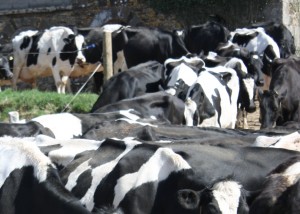


Comments are closed.